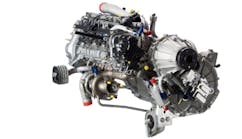Turbine Ignition Maintenance
By Jennifer Sparks and Brad Mottier November 1999
Most aircraft engines
rely on an electrical ignition system to create a spark, which in turn initiates or continues the engine's combustion process. Many laypersons and technicians are familiar with ignition systems used on internal combustion engines for automobiles and general aviation aircraft; however, ignition systems for gas turbine engines are probably the least understood and discussed. of all ignition systems. Compared to automotive systems, the spark discharge of a turbine ignition system is much larger, and, in some cases, the spark is over 100 times more powerful than the spark in an automobile engine.
The function of gas turbine ignition systems is to convert energy from some source to a high intensity electrical discharge (i.e., sparks). One good spark will initiate combustion of the fuel/air mixture in a turbine engine's combustor, however, several sparks are usually provided to ensure fast and reliable engine starts. Once the turbine engine is lit, the ignition system's job is finished unless the engine needs to be relit during an in-flight shutdown, or until the next operational cycle of the aircraft's turbine main engines or auxiliary power unit (APU) begins again.
Although the basic elements of every gas turbine ignition system are the same, even the sophisticated observer has trouble delineating amongst the various types. Actual performance, design, types and the physical appearances of most turbine-powered aircraft ignition systems differ from application to application. Engine operational requirements, combustor designs and performance parameters, operating environments, mounting considerations, FAA requirements, and differing design philosophies associated with providing reliable ignition are just a few of the reasons for the many models of turbine engine ignition systems in service today.
Though more reliable, today's turbine ignition systems are also more complex, requiring that aircraft technicians possess a higher degree of knowledge and understanding of turbine ignition system theory. Familiarity with a few basics will enable technicians to develop proper insight into standard operation, troubleshooting, and maintenance practices.
Turbine Ignition Systems Overview
The typical gas turbine engine ignition system consists of an exciter or exciters, an ignition lead or set of ignition leads, and an igniter
plug or set of igniter plugs. Furthermore, the different types of ignition systems can be broken down into two categories: low-tension ignition systems and high-tension ignition systems.
The heart of every turbine ignition system —both high and low tension — is the exciter, an engine- or airframe-mounted hermetically-sealed electrical box. The exciter uses input power from an airframe electrical bus or an engine-mounted generator to convert relatively low voltage to more useable, high-voltage energy pulses that fire an igniter plug and in turn ignite the fuel/air mixture. In order to deliver a high-energy discharge given the relatively low input power, a capacitor is charged up, and then all of the energy stored in the capacitor is released at once.
Conventional exciters use a spark gap as a switch to discharge the capacitor after it reaches a predetermined voltage level. An alternative to the older yet ever popular spark-gap-switch technology is the solid-state exciter. Invented and patented by Unison Industries, a solid-state exciter uses an electronic solid-state switch to regulate the energy discharge from the storage capacitor, resulting in precise control of discharge voltage, energy, and spark rate. For instance, a solid-state exciter can be designed to deliver a high spark rate during the engine starting cycle, then to reset itself to a lower spark rate during normal engine operation. This multi-mode capability ensures that sufficient energy is delivered to the air/fuel mixture to start the engine, and reduces wear and tear of the igniter plugs during normal engine operation.
After the spark gap or solid-state switch releases electrical energy from the storage capacitor, additional output circuitry in the exciter transforms the electrical energy into a discharge waveform. The exciter discharge is conducted through the ignition lead to the igniter plug where a spark is created that ignites the fuel/air mixture. Because engine combustor designs vary greatly, exciter discharge circuitry can be very complex. Depending on the application, exciter discharge voltages can range from 2,000 volts to over 20,000 volts, discharge current can be unidirectional or oscillatory, and even the shape of the discharge waveform can be modified and controlled.
High- and Low-Tension Ignition Systems
High-tension systems capable of delivering more than 8,000 volts per spark are used with surface-gap igniter plugs on most large commercial aircraft. This type of ignition system has the advantage of surface-gap igniter plug that naturally ceases to fire at high combustor pressures thereby reducing igniter tip erosion. Although the service life of high-tension igniter plugs can be as long as 3,500 engine hours, there is a size and weight trade off required to generate and deliver the firestorm of voltage a high-tension ignition system is capable of transferring. For this reason, some engine manufacturers prefer lighter and smaller low-tension ignition systems.
Low-tension ignition systems — deliver less than 8,000 volts to the engine's combustor. While there is the benefit of lighter weight and re-atively compact size, the voltage produced by these systems is usually not adequate to ionize a normal surface-gap igniter plug, there-fore, semiconductor plug technology is required. These plugs use a semiconductor material to initiate ionization between the igniter plug tip electrodes, resulting in the formation of a spark at a much lower voltage than in a non-semiconductor igniter plug. Low-tension igniter plugs typically do not quench at high combustion pressures requiring the pilot or the digital engine control to turn the ignition system off to prevent premature igniter plug wear. Typical low-tension igniter plug life is normally less than 500 hours.
Troubleshooting Turbine Ignition
Procedures for troubleshooting an ignition system on-wing are as variable as aircraft engines themselves. Some OEM manufacturers offer on-wing
test equipment that prevents unnecessary removal and recertification of healthy ignition systems, nonetheless, several of the following techniques are reliable procedures that should be incorporated into the technician's repertoire. Both high- and low-tension ignition systems should be discharged prior to routine inspection of any ignition system component. Most exciters incorporate a bleed-down resistor that will quickly dissipate any residual energy stored in the capacitor, but, as a second fail-safe, it is best to power down the system for a minimum of three minutes before beginning any system checks. Typically, it is not necessary to ground the system prior to performingcomponent inspections; however, such information should be verified against the most current version of an engine's component maintenance manual.
Although an audible check of the ignition system will not provide concrete substantiation of the condition of its components, this type of assessment can serve as a rudimentary tool in determining the likelihood of an ignition system malfunction. Unfortunately, a well-trained ear is necessary to distinguish the sound of a healthy ignition system from a functioning system that requires repair. Fully operational high- and low-tension igniter plugs are characterized by a snapping sound that is audible through an aircraft's exhaust duct.
The majority of engines are equipped with two plugs, and some dual-channel exciters fire these plugs simultaneously. As a result, it is possible to confuse the snapping sound of one operational plug for a healthy system though the second circuit is inoperable. If the igniter plugs fail to fire altogether, input power to the exciter should be verified using a digital multimeter. Most exciter data plates display input voltage, ampere requirements, and input connector polarity; however, an engine's maintenance manual is the most reliable source of specific data related to input power configuration. If the circuit breaker trips each time the ignition system is turned on, it is likely that the exciter has shorted and is drawing excessive current, or the airframe wiring harness has shorted to ground.
Turbine Ignition Maintenance
By Jennifer Sparks and Brad Mottier
November 1999
Turbine Ignition Inspection and Maintenance
Exciters Designed to require little or no maintenance, an ignition exciter often
lasts to engine TBO before recertification or overhaul of the unit is required. Repair of an exciter is costly and typically impractical because of the test equipment required to perform leak checks, tests of spark rate and insulation resistance. Due to the low cost and high reliability of exciter overhaul and exchange programs offered by the original equipment manufacturer, many airlines, as well as fleet and individual operators are taking advantage of overhaul programs. New or reconditioned units can be shipped back to customers or exchanged within a few days,making field repair of exciters more expensive and less attractive than the overhaul or exchange alternative.
Igniter Plugs
Igniter plug inspections consist of a simple distance measurement from the plug shell to the center electrode. The amount of shell material necessary to survive between scheduled inspection periods is determined by the engine and plug manufacturers respectively, and will vary from engine to engine. When this gap limit is reached, the plug should be replaced. Consideration of unusual flight conditions should influence recommended plug replacement schedules as well. For example, frequent, short flights resulting in a higher percentage of exciter "on-time" relative to total engine hours may considerably shorten the expected life of a plug. In this instance, replacement of plugs —even those that pass visual and electrical scrutiny — should be determined by the technician. Many plug manufacturers offer tools and gages to help determine plug serviceability.
There is little variation in inspection and maintenance procedures between high- and low-tension plugs; however, one difference needs to be noted — low-tension plugs operate most effectively when trace amounts of carbon are allowed to remain on the plug's firing tip. Carbon residue deposited on the tip of the plug during the combustion process
sh ould not be removed during normal cleaning procedure.
Ignition Leads
Ignition leads require little maintenance and can typically be counted
on to last through engine TBO. However, indications of arcing or flashover at the ignition lead connectors can typically be ttributed to trace amounts of grease or dirt in the exciter and igniter plug terminal wells. These areas must be clean before installing the ignition lead. A worn environmental seal on the lead, or an igniter plug with a breached seal, can also cause contamination of the igniter terminal well. Residual amounts of moisture, dirt, and other contaminants will ground an other-wise faultless ignition system. Clean-ing the output terminal wells of the exciter and the lead is paramount to proper ignition system performance, and usually requires little more than a lint-free cloth, and an appropriate cleaning solvent.
Flashover in the mating area of the ignition lead and the igniter plug will virtually guarantee the replacement of mating components. Inspect all connectors, paying close attention to the terminal well where the lead and plug couple. Likewise, the high-voltage discharge created by the ignition system will combine with high operating temperatures and eventu-ally compromise the integrity of the environmental seal — typically con-structed of a silicon compound — allowing moisture and other contami-nants to invade the terminal well. Replacement of the seal at every en-gine overhaul will reduce the likeli-hood of arcing, subsequent electrical failure, and costly replacement of the lead and plug. In more severe applications, seal replacement is required more frequently.
Visually inspect leads for obvious signs of carbon tracking on the in-sulators, indicative of a high-voltage flashover. Physical damage to the braided conduit assemblies is not permissible either. The metal braiding — an important part of the igni-tion system electrical circuit — provides protection to other engine and aircraft systems from electromagnetic interference, and is vital to the ef-ficient transfer of power from exciter to plug. Metal braiding containing more than four or five broken strands mandates replacement of the igni-tion lead. For field repair of ignition leads, repair kits can be purchased from lead manufacturers.
Performing periodic maintenance on an ignition system is essential to the overall flightworthiness of any aircraft. With periodic inspection and use of OEM manufacturer new and overhauled units and spare parts, maintenance costs and departure de-lays will be minimized.










